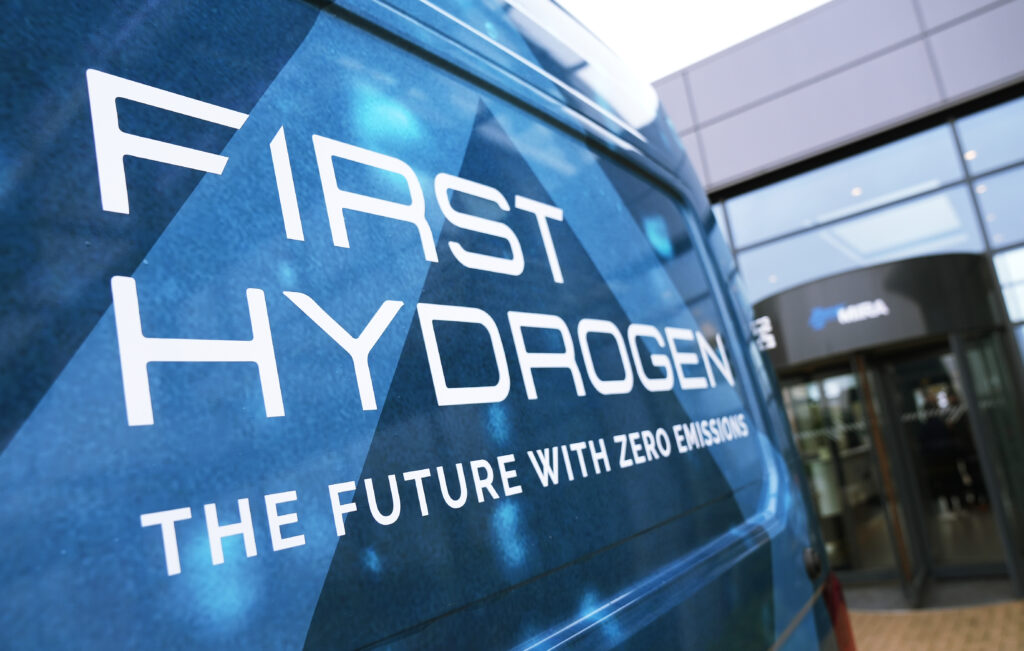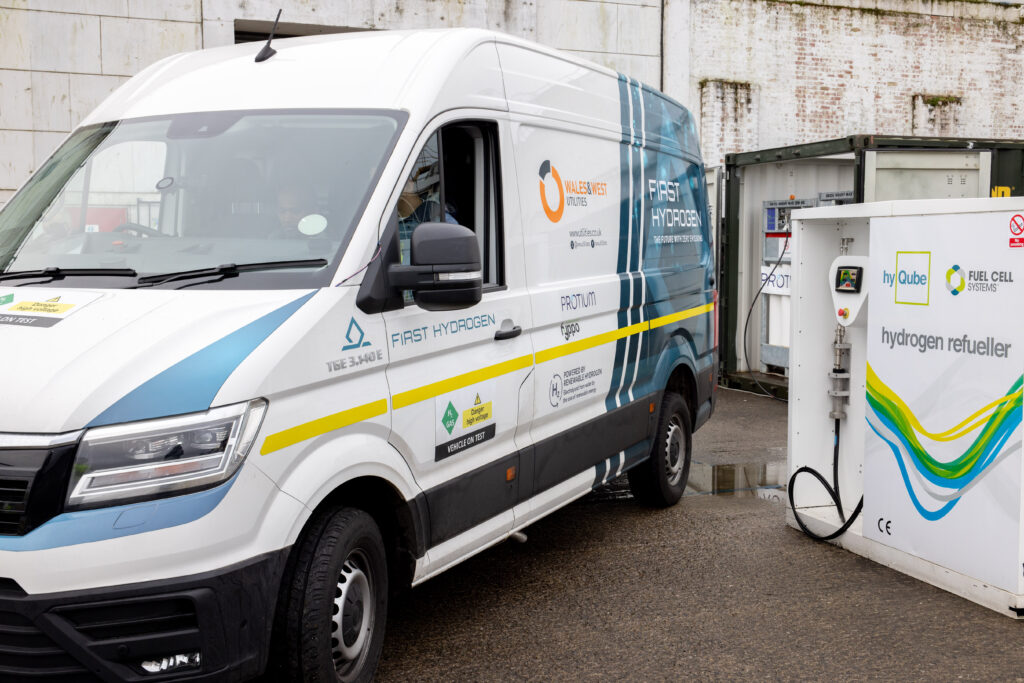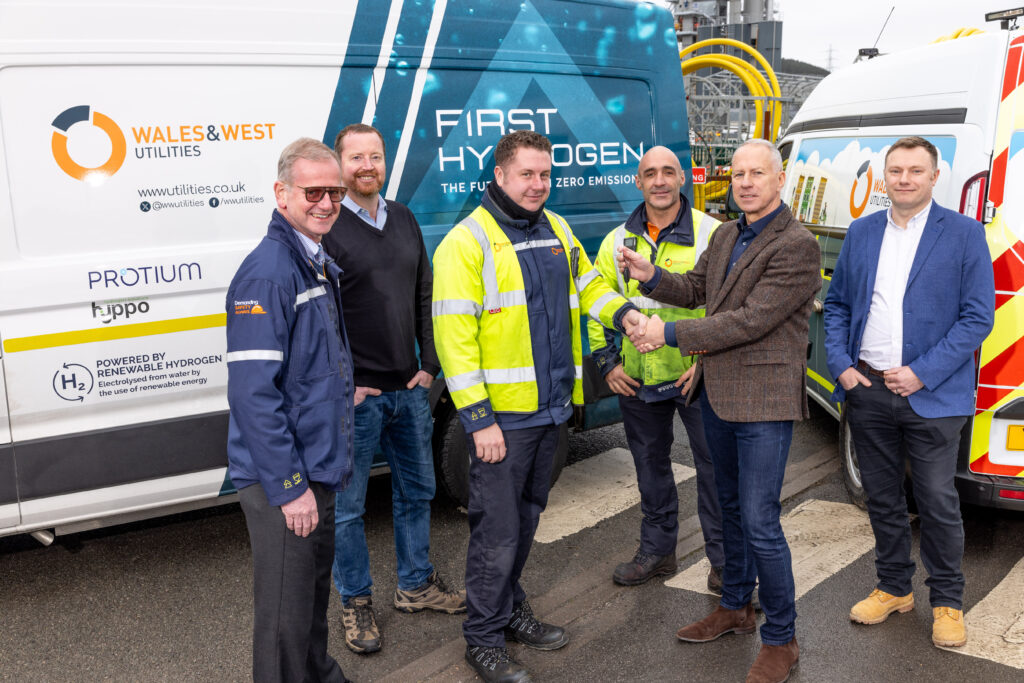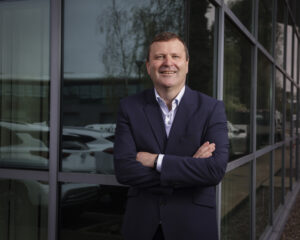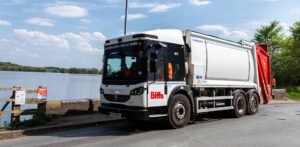The lack of fixed refuelling infrastructure didn’t stop green automotive developer First Hydrogen from undertaking vehicle trials with Wales & West Utilities. Allan Rushforth, First Hydrogen’s Chief Commercial Officer, explains how the company worked with local businesses to establish a hydrogen vehicle ecosystem in South Wales.
Many fleet operators see limitations in battery-electric vehicles. One of these is Wales & West Utilities (WWU). After attending First Hydrogen’s test drive of our demonstrator hydrogen-powered fuel-cell electric vehicles last year, the utility provider was keen to evaluate whether hydrogen could help decarbonise its local fleet.
Hydrogen is already accepted as a zero-emission solution for heavy vehicles, including HGVs, spreaders and construction vehicles, but at First Hydrogen, we see also potential in the light commercial vehicle (LCV) class. However, the region in which WWU operates was without hydrogen fuel stations. To overcome this challenge and enable the trial, we joined forces with local hydrogen businesses, Protium Green Solutions and Hyppo Hydrogen Solutions, to deliver a vehicle refuelling ecosystem.
Choosing hydrogen mobility
WWU’s fleet consists of 1,400 vehicles. Three-quarters of the vehicles are equipped to tow and must be installed with onboard power to charge phones, laptops, power pneumatic equipment and electrical tools on site. Current BEV technology could complete less than half of WWU’s operational journeys. In a document explaining the limitations of BEVs to the House of Lords Climate Change Committee enquiry into Electric Vehicles in September 2023, the business cited limited range, recharging network availability, and lack of towing or onboard power.
‘We are confident that hydrogen will play a fundamental role in delivering low-cost green energy as we move away from fossil fuels,’ said Stephen Offley, Transport Manager at Wales & West Utilities, in the submission. ‘Hydrogen can be produced from renewables in the UK and supplied through many of the gas pipelines we already use. We are already paving the way for the role of hydrogen in heating homes and powering industry, so using hydrogen fuel to decarbonise our fleets is a logical step.’
Developing a hydrogen vehicle ecosystem
Until now, First Hydrogen’s fleet operator trials have been conducted close to existing hydrogen fuel stations. However, the WWU trials set out to prove that hydrogen mobility could be deployed without access to fixed refuelling infrastructure. Our aim is to offer Hydrogen-as-a-Service, providing customers with vehicles, access to refuelling technology, and a supply of green hydrogen. In the UK, this will be achieved through partnerships. The WWU trial enabled us to pilot this approach.
We partnered with Protium for green hydrogen to fuel our FCEV. The fuel was produced locally with renewable power at Protium’s Pioneer 1 facility in Baglan. The site recently celebrated its first anniversary, and Pioneer 2 will be operational later in the year to meet the growing demand for green hydrogen.
Will Stinton, Protium Director of Operations, says: ‘These trials were an excellent opportunity to showcase the capability of green hydrogen, produced renewably by electrolysis, in fleet operations. Our experience in supporting transport trials has shown us that fuel-cell vehicles have an important role in meeting zero-emission targets and that drivers don’t find operating and refuelling an FCEV different to a diesel vehicle.’
Hyppo Hydrogen Solutions used its Fuel Cell Systems HyQube. This re-deployable hydrogen refuelling unit, developed by specialist engineers Fuel Cell Systems, was located near WWU’s Swansea depot, which is convenient for regular access. The technology can be deployed in remote locations and could help close gaps in the refuelling network while infrastructure matures.
Chris Foxall, CEO at Hyppo Hydrogen Solutions, says: ‘This trial demonstrates the readiness of the hydrogen technology available today and how we’re leveraging so many companies to deliver a bespoke solution which can be scaled and repeated in other areas.’
On the road
WWU deployed First Hydrogen’s 3.5-tonne FCEV prototype for use by two first-call operatives from the Network Emergency and Metering Services team responsible for emergency metering work in South Wales. After completing First Hydrogen’s driver training accreditation scheme, WWU’s operatives drove the vehicles for six to seven hours daily. They used the van to respond to customer callouts, completing five to six visits and travelling up to 189km (117 miles) daily. In four weeks, the vehicle accumulated 2,000km (>1,200 miles) on mostly urban roads and highways – the highest mileage we have reached during a trial yet.
In trials with SSE, a multi-national Scottish energy company, we confirmed the FCEV could drive more than 630km (>400 miles) on a single refuelling. The WWU trial confirmed how the fuel cell’s powertrain delivers power. Our vehicle achieved outputs of 60kW in transient accelerations, signifying that it is capable of more demanding duty cycles, including carrying heavier payloads, tackling hilly terrain, and delivering onboard power.
The trials took place in January and February. Cooler temperatures did not affect the vehicle’s performance, which is important as BEVs can struggle with reduced range and battery degradation in hotter and colder climates.
‘The trials allowed the transport team to experience the benefits of an FCEV first-hand, demonstrating its use in a frontline service role. They gave credible findings to share with our stakeholders and other fleet operators,’ says WWU’s Steve Offley. ‘The data generated also gives us a case to push for fixed hydrogen infrastructure in the area to benefit from faster refuelling and operational simplicity.’
All drivers commented on how smooth and easy the van drives and the refuelling speed. Alun Jones, First Call Operative for WWU and driver in the trials, says the van was ‘lovely’ to drive. ‘This is particularly impressive as this is a prototype vehicle. It allowed us to get on with our job. You can quickly refuel rather than charge up overnight, which is a massive advantage as sometimes we respond to calls from our homes in the middle of the night. I can see the hydrogen vans working at WWU regarding the efficiency we need.’
Next steps
While developing a hydrogen vehicle ecosystem proved that it is possible to overcome infrastructure barriers, fundamentally, these trials provided a model to build public confidence in hydrogen as a safe and valuable regional asset.
Our challenge now is establishing the economic and logistical viability of hydrogen-powered fleets. We are using data collected from the trial to model total cost of ownership projections for a business like WWU. This will help WWU and other construction and utility organisations to understand the affordability of transitioning to hydrogen.
